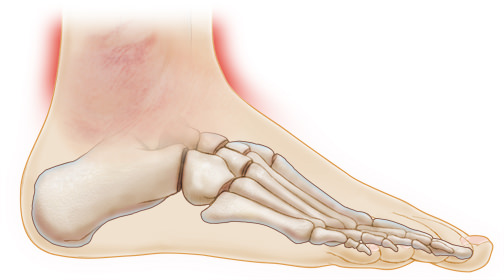Your ankle is the hinged joint where your foot and leg meet. It is composed of three bones—the tibia, fibula, and talus—and is surrounded by a network of ligaments and tendons. Ankles tend to take on a lot of stress, and are therefore prone to injury.
Sometimes even the mildest injury can result in ankle pain. Some ankle pain requires immediate attention, so it is important to seek treatment from your doctor when the pain is accompanied by additional symptoms such as swelling, bruising, or an inability to walk.
Ankle pain is often caused by a fracture or sprain, and is often accompanied by swelling and bruising. All ankle injuries that cause pain—even mild pain—should be looked at by a foot specialist. Ankle pain can be sharp or dull in nature, and can occur with or without weight-bearing. Ankle pain can also be a manifestation of another medical conditions or an infection.

Ankle Pain Symptoms To Be Aware Of
Ankle pain is sometimes associated with other symptoms:
- Swelling
- Redness
- Tenderness
- Stiffness
- Warmth
- Discoloration of the skin
- Fever
- Inability to bear weight
- Pain in other joints
Why Do I Have Ankle Pain?
Ankle pain is most commonly caused by an ankle sprain, but there can be numerous other causes for the pain. In most cases, there has been an injury to the bones, ligaments, or tendons within the ankle. Other causes of ankle pain include:
- Ankle instability
- Gout
- Pseudogout (this condition is similar to gout; it is characterized by calcium deposits in one or more joints that cause pain, redness, and swelling)
- Achilles tendonitis
- Achilles tendon rupture
- Strains
- Fractures
- Broken bones
- Tarsal tunnel syndrome (nerve compression)
- Viral or bacterial infection
- Poor structural alignment of the foot or leg
Types of arthritis that may cause ankle pain include:
- Rheumatoid arthritis
- Osteoarthritis
- Psoriatic arthritis
- Chronic gouty arthritis
- Septic arthritis
Knowing the cause of the ankle pain makes proper treatment possible. Some people do not report mild ankle injuries, and instead try to reduce symptoms such as swelling and redness on their own.
But without proper diagnosis and treatment, the original injury may not heal properly, making the ankle more susceptible to future injuries.
When to See Your Doctor About Your Ankle Pain
You should not decide whether to see your doctor based on the intensity of your pain. Not all injuries to your ankle are painful. If you experience any of the following symptoms you should see a doctor immediately:
- Exposed bone or tendon
- Inability to walk or stand without pain
- Severe pain and swelling
- Bruising that appears immediately after injury
- Signs of infection (redness, warmth, and tenderness)
- You can hear or feel a popping
- Swelling persists for two or three days
- Pain does not go away after one to three weeks
- You have a fever of 100° F (37.7° C)
How Is My Ankle Pain Diagnosed?
If you are experiencing ankle pain, you should seek medical attention to get a proper diagnosis.
Your doctor will perform a physical exam, paying close attention to your ankles, and may ask you questions about your activities and your medical history. He or she will also want to know what symptoms you are having.
Do not hold back when describing symptoms, as this can prevent the doctor from diagnosing you correctly.
Diagnostic tests such as x-rays may not show all problems. Your doctor may order additional imaging tests, such as an MRI (magnetic resonance imaging) or CT scan. In some cases, aspiration of synovial fluid (the fluid in the joint space) may be necessary for analysis.
How Can I Get Rid Of My Ankle Pain?
The type of treatment you receive for your ankle pain will be determined by the cause of the injury and the severity of the pain.
In most mild cases, your doctor will have you use the RICE method. This consists of Rest, Ice, Compression, and Elevation of your ankle. Ice should be applied for twenty minutes at a time. Compression involves wrapping the ankle with an elastic bandage to provide support, and elevation helps to minimize bruising and swelling.
Your doctor may also suggest using NSAIDs (non-steroidal anti-inflammatory drugs) such as ibuprofen, which can be bought over-the-counter.
If the pain is more severe, your doctor may inject your joint with an anesthetic or cortisone and advise you to undergo physical therapy. At times surgical intervention may be necessary if all conservative measures have been exhausted.
Recovering from your ankle pain may take days or months. Recovery periods typically depend on the severity and cause of the pain.
How Can I Prevent Ankle Pain From Happening?
The best way to prevent ankle injuries is to warm up before strenuous activities. Simple stretches and exercises can make your ligaments, tendons, joints, muscles, and bones less susceptible to damage.
Ankle pain may not always be easy to avoid. Simple ankle sprains are the most common cause of ankle pain, and they can occur at any age, at any time.
The best way to prevent ankle pain is to be aware of your surroundings, loosen up your muscles and joints before exercise, and see a doctor immediately if you are injured, even if the injury is mild.
Talking to Your Doctor
Here are some questions you may or may not want to ask your doctor if you are experiencing ankle pain:
- What orthotics can help reduce the pain during my normal activities?
- What type of exercises and stretches will benefit my feet and ankles most?
- What can I do to prevent the pain from recurring?




